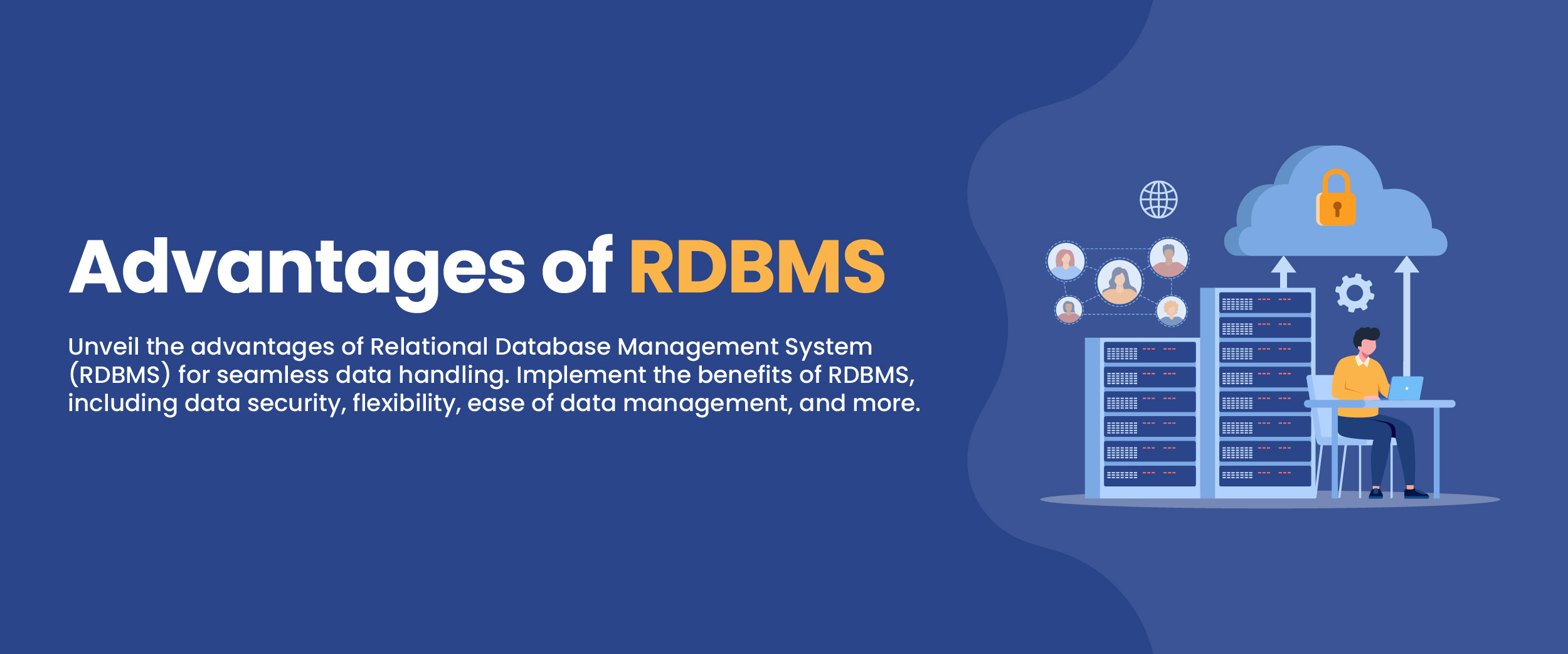15 Advantages and Disadvantages of RDBMS
Do you know that within the realm of modern data management, Relational Database Management Systems (RDBMS) have held paramount significance? Since their development in the 1970s, RDBMS have evolved significantly and have become the backbone of various industries, powering applications from finance and healthcare to e-commerce and social media. In this blog, we will explore the advantages and disadvantages of RDBMS and compare them with other data storage systems.
What is RDBMS?
RDBMS stands for Relational Database Management System. It is a software system that manages the storage, retrieval, and organization of data in a relational database. It uses a structured approach, with data organized into tables, each containing rows and columns, and supports SQL (Structured Query Language) for querying and manipulating the data. Learn SQL to understand more about databases.
RDBMS offers a wide array of benefits, making them a popular choice for data storage and management in various applications and industries. It also comes with certain drawbacks. Understanding both the advantages and disadvantages of RDBMS is crucial for making informed decisions when choosing the right database solution for specific use cases.
15 Advantages of RDBMS
Relational Database Management Systems (RDBMS) offer numerous advantages, making them widely used in various applications and industries. Here are some of the key advantages of RDBMS:
1. Data Structure
They organize data into tables with rows and columns, providing a structured and consistent way to store and manage data. This structure facilitates easy access, retrieval, and manipulation of data.
2. Data Integrity
They enforce data integrity through constraints, such as primary keys, foreign keys, and unique constraints. These constraints ensure that the data remains accurate and consistent, preventing the introduction of duplicate or invalid information.
3. Data Relationships
They enable the establishment of relationships between tables using primary and foreign keys. This feature allows data from different tables to be linked together, making it easier to query and analyze related information.
4. Querying and Reporting
They provide powerful query languages (e.g., SQL) that allow users to retrieve specific data from the database quickly. This simplicity and flexibility make it easier to generate reports and gain insights from the data.
5. Data Security
They offer robust security mechanisms to protect sensitive data. Access control features allow administrators to define user permissions and restrict unauthorized access to data.
6. Scalability
They can handle large amounts of data and scale up to accommodate the growth of the dataset and user demand. Many RDBMS platforms offer high-availability options and clustering to ensure system availability even during peak usage.
7. ACID Transactions
They support ACID (Atomicity, Consistency, Isolation, Durability) transactions, which guarantee that database operations are reliable and that data remains in a consistent state even in the event of failures.
Also, explore the key difference between DBMS and RDBMS.
8. Data Backup and Recovery
They provide tools and mechanisms to perform regular backups of the database, enabling data recovery in case of hardware failures, accidental deletions, or other unforeseen issues.
9. Data Indexing
They use indexing techniques to optimize data retrieval. Indexes speed up query execution by reducing the need for full-table scans, especially for large datasets.
10. Data Normalization
They encourage data normalization, which helps eliminate data redundancy and inconsistencies. Normalized data ensures efficient storage and minimizes update anomalies.
11. Industry Standard
RDBMS, such as MySQL, Oracle, Microsoft SQL Server, and PostgreSQL, have been around for decades and have established themselves as reliable, widely used, and well-supported solutions.
12. Data Consistency
They enforce referential integrity, ensuring that relationships between data remain consistent. This prevents data inconsistencies and maintains the accuracy and reliability of the information stored in the database.
13. Data Independence
They offer data abstraction, separating the logical structure of the database from its physical implementation. This data independence allows developers to modify the database schema without affecting the applications built on top of it, promoting flexibility and reducing maintenance efforts.
14. Data Accessibility
They provide concurrent access to multiple users and applications. Users can read and write data simultaneously without interfering with each other’s operations, promoting efficient collaboration and multi-user support.
15. Data Backup and Recovery
They typically offer various backup and recovery options, including full, incremental, and differential backups. These features ensure data protection and the ability to restore the database to a specific point in time.


15 Disadvantages of RDBMS
While Relational Database Management Systems (RDBMS) offer numerous advantages, they are not without their drawbacks. Here are some of the limitations of RDBMS:
1. Scalability Limitations
RDBMS may face challenges when dealing with extremely large datasets and high transaction volumes. As the data size grows, the performance of the RDBMS can degrade, requiring careful database design and optimization to maintain efficiency.
2. Complex Design
Designing a relational database schema can be complex, especially for large and intricate applications. Ensuring proper normalization and establishing appropriate relationships between tables can be time-consuming and require significant expertise.
3. Fixed Schema
They have a fixed schema, meaning the structure of the database is defined beforehand. Adding new columns or altering the schema often requires modifying existing applications, which can be cumbersome and may lead to downtime during updates.
4. Performance Bottlenecks
Certain operations, such as complex joins, can lead to performance bottlenecks in RDBMS, especially when dealing with large datasets. Proper indexing and query optimization are essential to mitigate these issues.
5. High Overhead
They typically have more overhead compared to some NoSQL databases. The need for data normalization, transactions, and referential integrity enforcement can result in increased storage requirements and slower performance.
6. Cost
Some commercial RDBMS solutions can be expensive, especially when considering licensing, maintenance, and hardware requirements. While open-source options like MySQL and PostgreSQL exist, implementing and managing RDBMS still incurs costs.
7. Replication Complexity
While RDBMS supports replication, setting up and managing replication can be complex, particularly in distributed and multi-data center environments.
8. Single Point of Failure
In traditional RDBMS setups, the database server can become a single point of failure. Ensuring high availability often requires implementing clustering or failover mechanisms, which can add complexity to the system.
9. Data Modeling Challenges
Representing certain types of data, such as hierarchical or unstructured data, can be challenging in a relational database. NoSQL databases may be better suited for handling these specific data types.
10. Data Type Limitations
RDBMS have predefined data types, and accommodating certain data formats or unstructured data can be difficult without resorting to workarounds.
11. Concurrency Issues
In heavily concurrent systems, managing locks and ensuring data consistency can be complex and may lead to potential contention and performance bottlenecks.
12. Learning Curve
They require users to be familiar with complex SQL queries and relational algebra. Mastering these skills can take time, especially for individuals new to database management.
13. Inflexibility with Changing Requirements
When the application’s requirements change frequently, altering the relational schema can be time-consuming and disruptive.
14. Complex Joins and Performance
While relational databases are excellent at handling structured data and enforcing data integrity, complex joins involving multiple tables can become a performance challenge. As the number of tables and the complexity of relationships increase, query execution times may also increase significantly.
15. Difficulty with Semi-Structured and Unstructured Data
RDBMS is not well-suited for handling semi-structured and unstructured data like JSON, XML, or documents. Some RDBMS provide support for storing and querying such data through specialized data types or extensions.
Conclusion
The advantages of RDBMS have no limit; they include data integrity, scalability, security, and standardized query language support. However, they also come with certain disadvantages and limitations, such as performance bottlenecks, scalability challenges for certain workloads, and a lack of flexibility for dynamic data. RDBMS remains a fundamental technology in the data management landscape, catering to a wide range of applications and industries with its robust and reliable data storage and retrieval capabilities.







